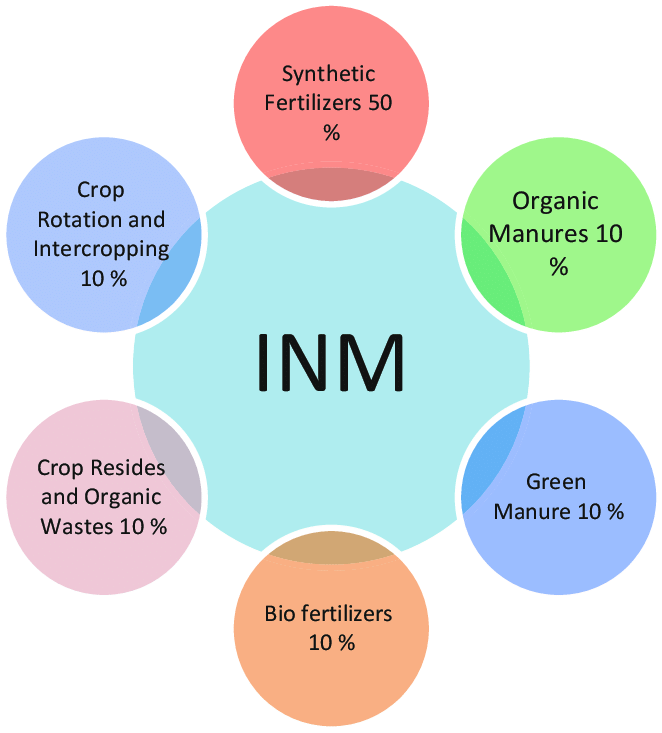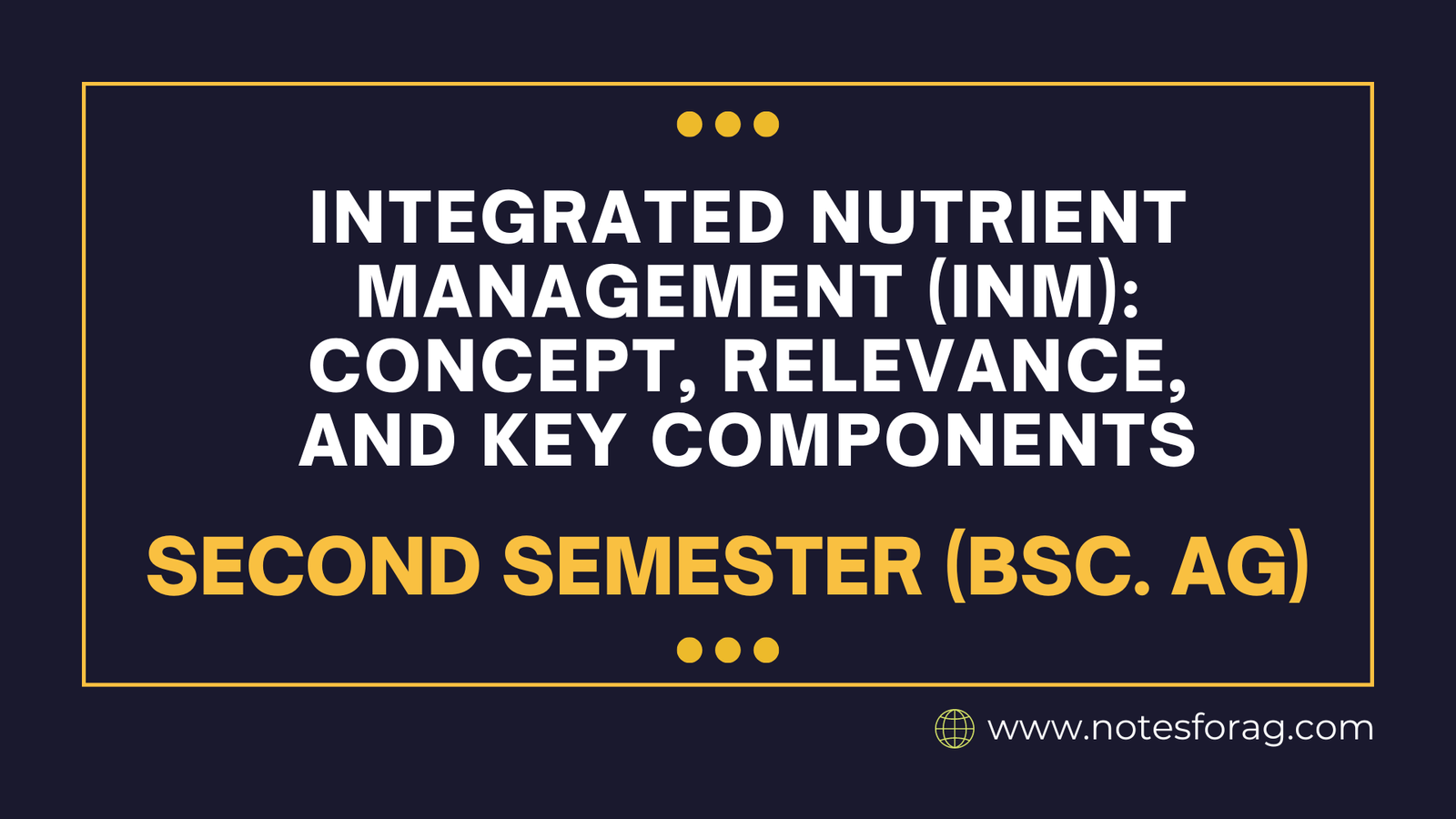Integrated Nutrient Management (INM) is a holistic strategy that integrates chemical fertilizers, organic manures, and biological sources to maximize crop nutrition and soil fertility. Maintaining agricultural output, enhancing soil health, and reducing environmental effects are its main objectives. Given the growing need for food worldwide, the deterioration of the soil, and the requirement for sustainable farming methods, INM is becoming more and more important. INM maintains long-term soil fertility, encourages sustainable farming, and improves nutrient usage efficiency by combining several nutrient sources and management techniques.
Table of Contents
Introduction to Integrated Nutrient Management (INM)
Integrated Fertilizer Management (INM) is a cutting-edge strategy in sustainable agriculture that maximizes crop productivity by utilizing all available nutrient sources. In order to preserve and improve agricultural yield and soil fertility, this all-encompassing approach aims to strike a balance between the utilization of biological, inorganic, and organic resources. Achieving long-term agricultural sustainability while reducing environmental impacts is the main objective of INM. INM makes sure that crops have a balanced supply of vital nutrients, which encourages healthier plant growth and larger harvests. It does this by integrating several nutrient sources.
It is impossible to overestimate the significance of INM in sustainable agriculture. The need for agricultural systems to produce more while preserving natural resources grows as the world’s food demand rises. INM promotes a balanced approach to nutrient management in order to address this difficulty. Utilizing the advantages of many nutrient sources—such as the instantaneous availability of nutrients from inorganic fertilizers, the benefits of organic matter for soil conditioning, and the biological improvement offered by microorganisms—it produces a synergistic impact that promotes healthy soil and robust crop output.
Relevance and Benefits of Integrated Nutrient Management (INM)
The significance of Integrated Nutrient Management (INM) in contemporary agriculture has expanded, mainly because of its diverse benefits to soil health, crop productivity, and environmental sustainability. INM promotes a more sustainable and balanced approach to farming by reducing dependency on chemical fertilizers and increasing nutrient use efficiency by mixing organic and inorganic nutrient sources.
The beneficial effects of INM on soil fertility are among its most noteworthy advantages. INM techniques enhance soil structure, water retention, and microbial activity by adding organic matter such as compost, green manure, and biofertilizers. This ensures long-term agricultural output by strengthening the soil against erosion and degradation and enriching it with vital nutrients.
Furthermore, INM makes a substantial contribution to environmental sustainability. When combined with organic amendments, the prudent application of chemical fertilizers reduces the amount of nutrients that flow off into bodies of water, hence lowering the danger of eutrophication and water pollution. By reducing the carbon footprint of agricultural operations, this balanced approach to nutrient management also plays a critical role in mitigating the effects of climate change. INM’s positive environmental effects are further highlighted by the inclusion of organic matter, which improves soil carbon sequestration.
Key Components of Integrated Nutrient Management (INM)
The goal of integrated nutrient management (INM), a comprehensive strategy, is to maximize crop yield and soil fertility by combining different fertilizer sources and management techniques. INM’s main ingredients include chemical fertilizers, biofertilizers, and organic manures. To keep the soil’s nutritional balance intact, each of these components is essential.

1. Chemical Fertilizers
- To satisfy the immediate needs of the crop, supply vital nutrients in forms that are easily accessible.
- Use with caution to prevent nutrient imbalances and overapplication.
2. Organic Manures
- Comprises crop residues, green manure, farmyard manure, and compost.
- Promotes microbial activity, increases soil organic matter, and strengthens soil structure.
3. Biological Sources
- Entails applying biofertilizers such as blue-green algae, mycorrhiza, Azotobacter, and Rhizobium.
- Aids in improving plant nutrient uptake, phosphate solubilization, and nitrogen fixation.
Challenges and Future Prospects of INM
A number of implementation issues with Integrated Nutrient Management (INM) prevent its widespread adoption. The main obstacle is farmers’ ignorance of the advantages and methods of integrated natural farming. Due to chemical fertilizers’ quick and obvious results, many farmers are not familiar with the idea of combining different sources of nutrients. To effectively inform and guide farmers, this knowledge gap demands significant educational efforts and extension services.
Another major issue is the restricted availability of organic inputs like compost, green manure, and biofertilizers. A vital part of integrated natural manuring (INM), organic inputs support both sustainable agriculture and healthy soil. However, there may be restrictions on their accessibility and cost, especially in rural or underdeveloped areas. By creating regional production facilities, supporting neighborhood-based projects, and offering financial incentives or subsidies to increase farmers’ access to organic inputs, this problem can be lessened.
Adoption of INM practices is further complicated by inadequate policy support. The use of chemical fertilizers is frequently emphasized by current agricultural policies, with little emphasis placed on encouraging integrated approaches. Encouraging regulations, research and development funding, and the creation of organic input certification programs are just a few of the policy interventions that are necessary to establish an environment that is conducive to innovation and manufacturing (INM).
In terms of INM’s future, a few innovations seem promising. The application of technology in precision agriculture can greatly improve the efficiency of nutrient management by applying it to input application. Digital tools, like smartphone apps and remote sensing technologies, can give farmers personalized recommendations and real-time data, enabling them to make well-informed decisions. Technological developments in biofertilizers, such as rhizobacteria that stimulate plant growth and microbial inoculants, provide sustainable substitutes for chemical fertilizers while enhancing soil fertility and crop yields.
Frequently Asked Question(FAQ)
What is Integrated Nutrient Management (INM)?
The agricultural technique known as Integrated Nutrient Management (INM) maximizes soil fertility and crop nutrition by combining the application of chemical fertilizers, organic manures, and biological sources. Maintaining agricultural productivity is the aim, along with improving soil health and reducing environmental effects.
Why is INM important?
INM is important because it handles the issue of soil degradation, environmental concerns, and the growing need for sustainable agricultural practices. It lessens the harmful effects of overusing chemical fertilizers, increases nutrient use efficiency, and helps preserve soil fertility.
Related Articles

